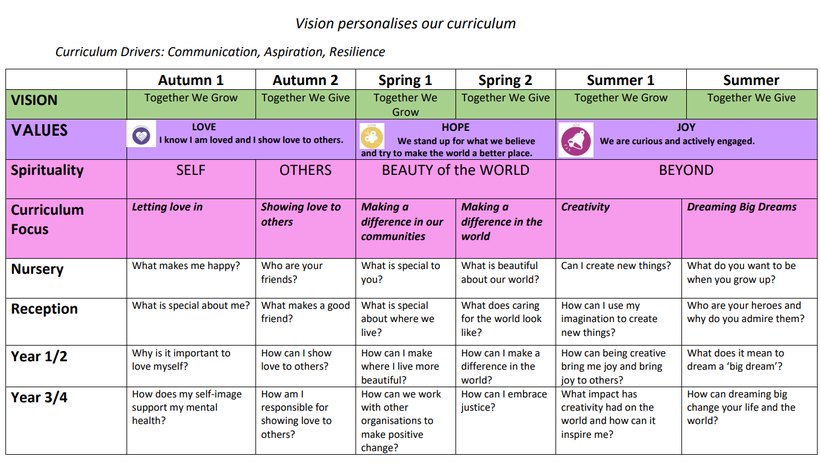Our Vision
Our approach to the curriculum is firmly rooted in our vision:
‘Together We Grow: Together We Give.’
and its associated values of LOVE, HOPE and JOY
Our six curriculum themes linked to our vision aims to develop our children’s awareness about: themselves and others; our world and our role as its custodian and how we can 'be the change we want to see in the world':

At Wimborne St Giles, we believe that through a progressive and carefully sequenced curriculum we are 'planting trees for the future'. We want our children to become compassionate, curious and nurturing global citizens who see themselves as active participants in the world in which they live.
Our Curriculum Intent:
“And the leaves of the tree are for the healing of the nation" (Revelation 22:2)
At Wimborne St Giles, we have designed a curriculum that aims to be irresistible and ambitious and equips all our children so that they flourish and, in turn, support the flourishing of their own community and the world beyond.
In order to ensure that learning is relevant and meaningful to all our pupils, skills are learnt alongside knowledge, predominantly through the delivery of a fully inclusive curriculum. Teaching and learning in this way supports children to make connections within and across their learning experience. Immersive cross-curricular teaching allows children’s natural curiosity to flourish, alongside the purposeful acquisition of knowledge and skills; deepening their engagement and understanding. At Wimborne St Giles, we firmly believe that every child can master an understanding and love of all subjects. All our children are taught each subject for mastery through an inclusive and transformative approach, which helps every child to develop a deep, long-term and adaptable understanding of each subject.
Carefully planned opportunities aim to inspire a life-long love of learning, promoting positive learning behaviours and helping all our children to grow as confident and ambitious individuals, ready to thrive in an ever changing world.
Through the curriculum, all our children will have the opportunity to become the best communicators, innovators, creators, designers and performers they can be. They will learn about the wonders of the world around them, with opportunities to investigate the history, geography and science of their world. They will learn about themselves as human beings, their place within their community and the world beyond and begin to understand the positive impact they can have on their own lives, the lives of others and on the world in which they live.
A Curriculum for Everyone
At St Giles, all teachers are responsible for providing an inclusive and ambitious curriculum so that children with Special Educational Needs or Disabilities (SEND) have equal access to the curriculum. We have high expectations for all pupils and are committed to ensuring our curriculum complies with the Equality Act 2010 and the Special Educational Needs and Disability Regulations 2014.
We aim to challenge that mindset that seeks to predetermine the capacity of each learner, replacing it instead with a curiosity about what the learner can achieve. As teachers we should approach teaching with a sense of openness, looking to be surprised by our learners and what they can achieve.
...our curriculum should whisper to our children, “You belong. You did not come from nowhere. All this came before you, and one day you too might add to it.”(Ben Newmark)
Through the design of our curriculum and its implementation, we aim to create learning spaces where all children belong. At St Giles how we build a fully inclusive space for all and particularly those learners experiencing disadvantage, is crucial.
Our inclusion statement emphasises the importance of providing an inclusive learning environment for all pupils including those with SEND. Additional information on this can be found in our Special Education Needs Information Report and Equalities Policy.
At Wimborne St Giles, in order to achieve the ambitious aims we set for our children, we implement our curriculum in the following ways:
- All our learning is underpinned by our Christian values of: Love, Hope and Joy
- All staff work together to ensure that teaching and learning takes place, in a fully inclusive environment ,where everyone feels safe, respected and valued as unique individuals
- Teaching and learning is set within a stimulating environment and delivered by inspiring staff committed to supporting each child to be successful and reach their full potential
- Learning is coherently planned and sequenced through discreet teaching of every subject, to ensure progression and continuity across the school
- A 'Big Question' forms the starting point for enquiry based learning promoting critical thinking, problem solving, creativity and communication
- All children have regular opportunities to work both collaboratively and independently, where they are supported to develop resilience, become self-reflective learners and feel confident to rise to new challenges
- WOW Days and Experiences are planned during each unit of learning, to stimulate curiosity and promote engagement in the new learning
- Additional Creative Curriculum Days are carefully planned throughout the year, to further enrich curriculum knowledge and skills
- Enriched extra-curricular activities and experiences are planned for all children to access as part of the our 'Grow and Give' programme which is timetabled and carefully planned each week - this presents all our children with opportunities they may not otherwise be able to experience, with new skills to acquire and also provides them with opportunities to serve the wider local, national and global communitie
Curriculum Overview for the Early Years Foundation Stage (Nursery and Reception)
Reception
In the Early Years Foundation Stage, there are 7 areas of development as shown below e.g. Physical Development. Each of these areas contains aspects relating to that area e.g. Moving and Handling. There are 17 aspects in total. Each aspect contains one or several development statements. The aim at the end of school reception class is that the Early Learning Goals identified below are met in full for each child.
